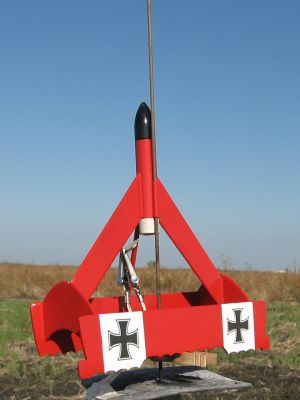| Construction Rating: | starstarstarstarstar |
| Flight Rating: | starstarstarstarstar |
| Overall Rating: | starstarstarstarstar |
| Manufacturer: | Squirrel Works  |
| Skill Level: | 2 |
| Style: | Glider |
Brief:
Don is such a nice guy. I fouled up the first kit he gave me to beta test years ago, gluing the rudders on backward.
Needless to say, I could never get it trimmed for flight. Now that he has redesigned the way the parts fit together, he
has once again provided another for me to beta test. Success! The newer design is almost fool proof. He won't admit it,
but I think he redesigned it with me in mind. It is a BT-20 based rocket glider that flies excellently on 18mm motors.
Terri was thinking of changing the face card, but I'm glad they left it the same. It really looks fantastic.

Construction:
The instructions are numbered with lots of helpful illustrations. I glued everything together with yellow glue. The
wings and rudders are laser cut. I really wouldn't want to cut out those scallops in the upper and lower wings! The
rudders are now two laser-cut pieces, tabbed on the upper and lower pieces to fit into slots in the upper and lower
wings. The two pieces are glued together leaving a slot in the middle for the tabs on the center wings to glue into.
The balsa nose cone is top quality and very smooth. A BT-20 tube is used for the body and a sheet of water slide decals
is provided with a variety of optional markings. A balsa strut attaches from the body tube to a notch in the center of
the lower wing. Glue the nose cone and launch lug onto the body tube and you're done! The motor is ejected so the
glider is balanced for flight without the motor. Clay is provided for balancing.
Finishing:
The balsa nose cone required very little finishing. With only a very light coat of Elmer's Light Fill ‘n'
Finish, the nose cone was very smooth. I also applied only a light coat of Fill ‘n' Finish to the body tube and
fins to minimize the weight. I pre-sanded the wings and strut using 240 and 400 grit sandpaper before removing from the
balsa sheet. I sprayed the entire model with a very light coat of Kilz to seal off the glue and provide a solid base
coat. Next, I lightly sanded the entire model with 240 grit sandpaper and then sprayed on a light coat of primer
sanding with 400 grit sandpaper. I used Krylon paint following the red and black paint scheme on the face card. After
drying for 24 hours, I applied the decals and then covered everything with a thin coat of Future floor finish.
Construction Rating: 5 out of 5
Flight and Recovery:
First flight was on an Estes B6-2 with the wind speed at about 5 mph. It zoomed straight up with ejection right at
the top. The glider did a barrel roll and then settled into a 50-yard wide slow circle down. Perfect! It probably
stayed up in the air for close to a minute. Pretty good considering the temperature was about 70 degrees. It only took
a couple of tosses with a very slight adjustment to the clay to balance the glider again for its next flight. The next
flight was on an A8-3, another perfect flight with similar glide pattern. Chas Russell timed the flight at 33 seconds.
I was elated! The flights were just beautiful. I decided to go with a B4-2 for the next flight. Again, it only took a
couple of tosses to get the glider re-trimmed. Another perfectly straight boost up, but at ejection there was a very
loud POW! The shock split the rudders in half, separating the upper wing, and cracking the lower wing where the strut
joined. The glider flipped over a couple of times and the upper wing came floating down. Unbelievably, the rocket
continued to glide for about 15-20 seconds with only the center and lower wings attached to the lower half of the
rudders before fluttering down the last 30 feet from the ground. Upon inspection of the motor, the upper end was flared
out, and I only had it lightly taped in just enough to keep it from falling out on the launch pad. That was just one
hot ejection charge!
Flight Rating: 5 out of 5
Summary:
I was very impressed with the glider. It was a snap to put together and flew beautifully. I felt redeemed. I am not a
glider person either. This was only my third glider to build, not counting the first Red Baron I put together. It took
about 50 tosses to get the trim dialed in, but once I had done that, only very minor adjustment to the clay was needed
for each flight on the field.
Overall Rating: 5 out of 5
Other Reviews
- Squirrel Works Red Baron By mark hernandez
Brief: The Red Baron from Squirrel Works is yet another great kit from that company. A unique boost glider that is easy to assemble and a joy to fly. As with all the other kits from Squirrel Works, this kit comes professionally packaged in a plastic bag with color face and header cards. The face card lists all the specifications of the rocket and recommended engines. The face card on ...
 |
 |
Flights
 |
 |